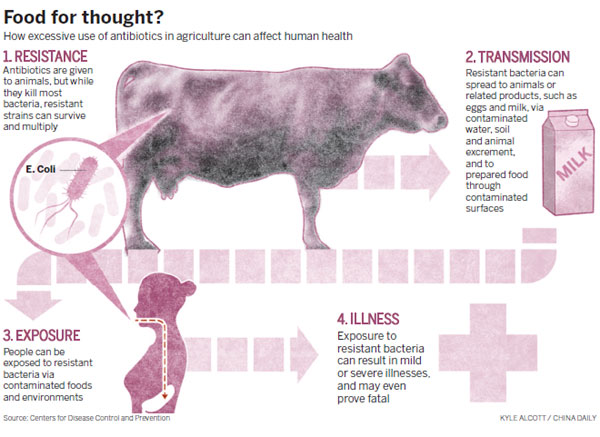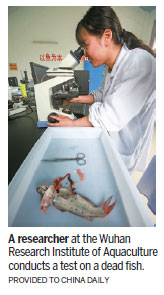
Unscreened residue
"The antibiotic residue is not screened before animal products hit the market," Xiao said, pointing out that regulations on the correct use of antibiotics in animal feed are not enforced strictly enough.
Su Jiufu, a duck farmer in Pucheng county, Weinan city, in the northwestern province of Shaanxi, said he doesn't think there is a problem: "I often eat the meat and eggs of the ducks on my farm."
He generally sells his produce to grocery stores in the local township. "Storekeepers have never asked me about antibiotic use," he said.
As an experienced farmer, Su acknowledged that antibiotic use is relatively common at duck farms because the birds are prone to diseases.
The most commonly used antibiotics are Ciprofloxacin and Jinsaiwei, which are regularly added to the ducks' food, he said.
"That's not only for treatment, but prevention. Otherwise ducks can easily contract viral hepatitis, duck plague and fowl cholera, which spreads quickly, causing deaths and a loss of income for the farmers," he added.
Zeng Xiaoxiang, who owns a chicken farm in Meizhou, Guangdong province, sells about 100,000 fowls a year. She said white-feathered breeds of chickens commonly seen on market stalls need to be given antibiotics almost every day to treat and prevent diseases such as bronchitis and enteritidis, a type of salmonella.
"The drugs, mainly antibiotics, such as penicillin and amoxycillin, and vaccines cost 150,000 yuan ($22,400) every year," she said. "The doses are usually increased during winter, when chickens are at greater risk of disease."
Resistance gene
Excessive antibiotic use has already taken a toll. In 2011, researchers detected the MCR-1 resistance gene - which renders colistin, a so-called last-line antibiotic, ineffective - in 5 percent of chicken and pork samples collected from markets around the country.
However, by the end of 2014, the proportion had risen to 25 percent. Late last year, a study led by Liu Yiyun, a professor at South China Agriculture University in Guangzhou, Guangdong province, was published in the renowned UK medical journal Lancet Infectious Diseases. The study found that the MCR-1 resistance gene had been identified in a number of samples provided by hospital patients in the province.
"The gene can pass around among certain types of bacteria that exist in both animals and humans," said Huang Liuyu, director of the Institute for Disease Prevention and Control with the People's Liberation Army.
According to Huang, excessive antibiotic residue in animal products could be transmitted to humans via the consumption of meat, eggs and milk, increasing the possibility of increased resistance to antibiotics.
Also, the problem may "travel" and contaminate people in other parts of the world as a result of increasing international travel and interpersonal exchanges, he said.
Globally, antimicrobial drugs are becoming less effective and the world is not developing enough new antibiotics to replace those that are now almost redundant, according to the UK report.
O'Neill, the leader of the UK study, emphasized the need for measures to tackle the problem. "It's a serious global challenge, and thus it needs a global solution," he said.

